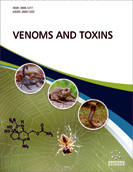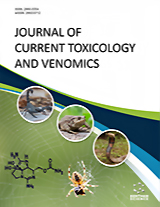Abstract
Parkinson’s disease (PD) has caused most economies to lose their active human capital. Due to poor understanding of the pathophysiology of PD, PD animal models were developed to aid the investigation of PD pathogenesis and therapy. Currently, the toxin-induced and the genetic animal models are being used for most PD research.
Most neurotoxin animal model studies on PD are focused on the motor features and economic importance associated with dopamine depletion; however, the molecular pathways for cell loss by these models and its usefulness in PD drug development have not been reported fully. In this review, we have provided a summary of the toxic mechanism and shortcomings of four neurotoxins (6-OHDA, MPTP, Rotenone and, Paraquat) that are frequently used to mimic PD in animal models. This review will give readers basic knowledge for selecting the best toxin for a specific PD experiment and also provide information that will help in the future development of toxins with fewer shortcomings. This review also summarizes the mechanism and features of some PD genetic models.Keywords: Parkinson`s disease (PD), etiology, pathogenesis, toxin-induced model, genetic models, neurotoxic mechanism, shortcomings.
Graphical Abstract
[http://dx.doi.org/10.1038/nature23664] [PMID: 28858313]
[http://dx.doi.org/10.1016/j.arr.2014.01.004] [PMID: 24503004]
[http://dx.doi.org/10.3389/fneur.2012.00088] [PMID: 22654785]
[http://dx.doi.org/10.1111/nan.12110] [PMID: 24372386]
[http://dx.doi.org/10.1016/j.coms.2007.12.012] [PMID: 18343329]
[http://dx.doi.org/10.1155/2012/845618] [PMID: 22536024]
[http://dx.doi.org/10.2174/1389202914666131210195808] [PMID: 24532982]
[PMID: 2215971]
[http://dx.doi.org/10.1016/B978-0-444-62627-1.00013-5] [PMID: 26563792]
[http://dx.doi.org/10.1016/S1474-4422(06)70471-9]
[http://dx.doi.org/10.2174/0929867325666171129124616] [PMID: 29189118]
[http://dx.doi.org/10.1001/archneur.62.1.91] [PMID: 15642854]
[http://dx.doi.org/10.1126/science.6823561] [PMID: 6823561]
[http://dx.doi.org/10.1152/physrev.00022.2010] [PMID: 22013209]
[http://dx.doi.org/10.1093/hmg/ddh089] [PMID: 14976155]
[http://dx.doi.org/10.1016/0169-328X(94)00209-W] [PMID: 7723627]
[http://dx.doi.org/10.1126/science.276.5321.2045] [PMID: 9197268]
[http://dx.doi.org/10.1126/science.1093891] [PMID: 15105460]
[http://dx.doi.org/10.1111/j.1600-0854.2008.00853.x] [PMID: 18980610]
[http://dx.doi.org/10.1371/journal.pone.0017698] [PMID: 21408191]
[http://dx.doi.org/10.1007/PL00007740] [PMID: 9808333]
[http://dx.doi.org/10.1002/ana.410440712] [PMID: 9749577]
[http://dx.doi.org/10.1002/mds.27414] [PMID: 29704272]
[http://dx.doi.org/10.1016/j.expneurol.2017.10.003] [PMID: 28987463]
[http://dx.doi.org/10.1016/S1474-4422(08)70117-0] [PMID: 18539534]
[http://dx.doi.org/10.1007/s11910-015-0564-y] [PMID: 26008812]
[http://dx.doi.org/10.1016/j.neuron.2005.01.041] [PMID: 15721235]
[http://dx.doi.org/10.1016/j.ejphar.2013.11.036] [PMID: 24333475]
[http://dx.doi.org/10.1002/prca.201500092] [PMID: 26749507]
[http://dx.doi.org/10.1016/0166-2236(93)90070-3] [PMID: 7507613]
[http://dx.doi.org/10.1016/j.cbi.2005.12.009] [PMID: 16430879]
[http://dx.doi.org/10.1001/archneurol.2010.144] [PMID: 20625087]
[http://dx.doi.org/10.1007/s11357-011-9284-7] [PMID: 21713375]
[http://dx.doi.org/10.1111/j.1471-4159.1990.tb02325.x] [PMID: 2154550]
[http://dx.doi.org/10.1006/exnr.1994.1187] [PMID: 7529713]
[http://dx.doi.org/10.5387/fms.59.76] [PMID: 24500382]
[http://dx.doi.org/10.1002/mds.870060103] [PMID: 1848677]
[http://dx.doi.org/10.1016/j.neuron.2010.04.034] [PMID: 20547124]
[http://dx.doi.org/10.1016/S1474-4422(11)70227-7] [PMID: 22094131]
[http://dx.doi.org/10.1101/cshperspect.a009316] [PMID: 22229125]
[http://dx.doi.org/10.1002/jnr.23708] [PMID: 26762168]
[http://dx.doi.org/10.1111/j.1742-4658.2012.08491.x] [PMID: 22251459]
[http://dx.doi.org/10.1046/j.1471-4159.1996.66052004.x] [PMID: 8780029]
[http://dx.doi.org/10.1016/0014-2999(68)90164-7] [PMID: 5718510]
[http://dx.doi.org/10.1016/j.neuroscience.2011.10.057] [PMID: 22108613]
[http://dx.doi.org/10.1016/0014-2999(68)90056-3] [PMID: 5654676]
[http://dx.doi.org/10.3791/3234] [PMID: 22370630]
[http://dx.doi.org/10.1016/j.parkreldis.2008.04.015] [PMID: 18595767]
[http://dx.doi.org/10.1007/BF03159728] [PMID: 2504173]
[http://dx.doi.org/10.5772/63328]
[http://dx.doi.org/10.1007/s12640-017-9778-x] [PMID: 28707266]
[http://dx.doi.org/10.1093/intbio/zyz031] [PMID: 31851358]
[http://dx.doi.org/10.1016/j.nrl.2015.06.011] [PMID: 26304655]
[http://dx.doi.org/10.1016/0006-2952(75)90304-4] [PMID: 1092302]
[http://dx.doi.org/10.1111/j.1471-4159.2004.02471.x] [PMID: 15198664]
[http://dx.doi.org/10.1006/neur.1995.0016] [PMID: 7583676]
[PMID: 5125851]
[http://dx.doi.org/10.5607/en.2013.22.1.11] [PMID: 23585717]
[http://dx.doi.org/10.1007/s12640-016-9693-6] [PMID: 28130746]
[http://dx.doi.org/10.1016/j.nbd.2011.04.007] [PMID: 21515375]
[http://dx.doi.org/10.1016/S0896-6273(03)00568-3] [PMID: 12971891]
[http://dx.doi.org/10.33549/physiolres.933895] [PMID: 30433804]
[http://dx.doi.org/10.1016/0006-8993(76)90877-5] [PMID: 1247882]
[http://dx.doi.org/10.1155/2019/9348075]
[http://dx.doi.org/10.1371/journal.pgen.1007125] [PMID: 29346382]
[http://dx.doi.org/10.1038/s41598-019-53413-w] [PMID: 31745133]
[http://dx.doi.org/10.1016/j.bbr.2019.111981] [PMID: 31141725]
[http://dx.doi.org/10.1016/j.pbb.2011.09.009] [PMID: 21978941]
[http://dx.doi.org/10.1002/mds.22801] [PMID: 20187241]
[http://dx.doi.org/10.1016/j.biopsych.2008.09.008] [PMID: 18947822]
[PMID: 27307952]
[http://dx.doi.org/10.1186/1742-2094-1-6] [PMID: 15285796]
[http://dx.doi.org/10.1038/mt.2010.135] [PMID: 20606642]
[http://dx.doi.org/10.1089/hum.2011.220] [PMID: 22424171]
[http://dx.doi.org/10.1111/j.1476-5381.2011.01426.x] [PMID: 21486284]
[http://dx.doi.org/10.1520/JFS11978J] [PMID: 3259617]
[http://dx.doi.org/10.1046/j.1471-4159.2001.00183.x] [PMID: 11238711]
[http://dx.doi.org/10.1056/NEJM198505303122203] [PMID: 2581135]
[http://dx.doi.org/10.1016/j.freeradbiomed.2013.10.013] [PMID: 24140863]
[PMID: 7932147]
[http://dx.doi.org/10.1097/WNR.0000000000000871] [PMID: 28902711]
[http://dx.doi.org/10.1016/j.neuropharm.2017.02.022] [PMID: 28238714]
[http://dx.doi.org/10.1016/0024-3205(85)90146-8] [PMID: 2861548]
[http://dx.doi.org/10.1093/hmg/ddz271] [PMID: 31813996]
[http://dx.doi.org/10.1016/j.jns.2017.08.3251] [PMID: 28991704]
[http://dx.doi.org/10.1073/pnas.0900358106] [PMID: 19416912]
[http://dx.doi.org/10.1111/j.1471-4159.1987.tb05737.x] [PMID: 3106573]
[http://dx.doi.org/10.1155/2017/9349487] [PMID: 28831326]
[http://dx.doi.org/10.3389/fnins.2018.00090] [PMID: 29515360]
[http://dx.doi.org/10.1038/jcbfm.2014.162] [PMID: 25248837]
[http://dx.doi.org/10.18632/oncotarget.10504] [PMID: 27409674]
[http://dx.doi.org/10.3945/jn.117.255034] [PMID: 28835392]
[http://dx.doi.org/10.1016/S0079-6123(10)84007-5] [PMID: 20887873]
[http://dx.doi.org/10.1002/mds.22481] [PMID: 19526568]
[http://dx.doi.org/10.1016/S0166-4328(01)00309-6] [PMID: 11682102]
[http://dx.doi.org/10.1111/j.0953-816X.2003.03088.x] [PMID: 14725637]
[http://dx.doi.org/10.1201/9781420004335.ch9]
[http://dx.doi.org/10.1126/science.2402638] [PMID: 2402638]
[http://dx.doi.org/10.1056/NEJM199810153391603] [PMID: 9770557]
[http://dx.doi.org/10.1038/380252a0] [PMID: 8637574]
[http://dx.doi.org/10.1126/science.290.5492.767] [PMID: 11052933]
[http://dx.doi.org/10.1177/1759091418777438] [PMID: 29809058]
[http://dx.doi.org/10.2147/DDDT.S156920] [PMID: 29588573]
[http://dx.doi.org/10.1074/jbc.RA119.008848] [PMID: 31113867]
[http://dx.doi.org/10.3389/fncel.2019.00018] [PMID: 30804756]
[http://dx.doi.org/10.1016/S0896-6273(03)00126-0] [PMID: 12670420]
[http://dx.doi.org/10.1111/j.1471-4159.2005.03341.x] [PMID: 16181414]
[http://dx.doi.org/10.1016/S1353-8020(11)70047-5] [PMID: 22166418]
[http://dx.doi.org/10.1016/S1567-5769(02)00078-4] [PMID: 12349958]
[http://dx.doi.org/10.1021/ed081p1457]
[http://dx.doi.org/10.1104/pp.110.161430] [PMID: 20921162]
[http://dx.doi.org/10.1039/9781849733007]
[http://dx.doi.org/10.1074/jbc.M105326200] [PMID: 11724769]
[http://dx.doi.org/10.1038/81834] [PMID: 11100151]
[http://dx.doi.org/10.1248/bpb.34.92] [PMID: 21212524]
[http://dx.doi.org/10.1016/j.tips.2009.12.006] [PMID: 20096940]
[http://dx.doi.org/10.1016/j.tox.2010.03.019] [PMID: 20371261]
[http://dx.doi.org/10.1046/j.1471-4159.2000.0752611.x] [PMID: 11080215]
[http://dx.doi.org/10.1016/j.neuro.2014.12.002] [PMID: 25514659]
[http://dx.doi.org/10.1016/j.nbd.2009.01.016] [PMID: 19385059]
[http://dx.doi.org/10.1007/s00204-017-2133-4] [PMID: 29209747]
[http://dx.doi.org/10.1016/S0005-2728(01)00183-9] [PMID: 11418099]
[http://dx.doi.org/10.1111/j.1742-4658.2007.06004.x] [PMID: 17697112]
[http://dx.doi.org/10.1016/0304-4165(78)90315-X] [PMID: 568944]
[http://dx.doi.org/10.1016/j.pathophys.2017.01.001] [PMID: 28126254]
[http://dx.doi.org/10.1093/brain/awq322] [PMID: 21147837]
[http://dx.doi.org/10.1016/j.bbr.2014.11.002]
[http://dx.doi.org/10.1006/exnr.2002.8072] [PMID: 12504863]
[http://dx.doi.org/10.1016/j.expneurol.2004.01.023] [PMID: 15144868]
[http://dx.doi.org/10.1096/fj.03-0677fje] [PMID: 14766796]
[http://dx.doi.org/10.1093/toxsci/kfz127] [PMID: 31161199]
[http://dx.doi.org/10.1093/toxsci/kfz082] [PMID: 30907971]
[http://dx.doi.org/10.3390/ijerph16203811]
[http://dx.doi.org/10.1155/2019/6843265] [PMID: 30949504]
[http://dx.doi.org/10.1016/j.neulet.2019.01.057] [PMID: 30716425]
[http://dx.doi.org/10.1007/s12035-017-0855-1] [PMID: 29327204]
[http://dx.doi.org/10.1038/s41598-017-07442-y] [PMID: 28855526]
[http://dx.doi.org/10.5812/gct.92178]
[http://dx.doi.org/10.1016/j.bbr.2003.12.021] [PMID: 15265640]
[http://dx.doi.org/10.1016/j.tox.2012.06.007] [PMID: 22727881]
[http://dx.doi.org/10.1016/j.neuint.2005.12.016] [PMID: 16490285]
[http://dx.doi.org/10.1016/j.neuint.2009.07.009] [PMID: 19647776]
[http://dx.doi.org/10.1602/neurorx.2.3.484] [PMID: 16389312]
[http://dx.doi.org/10.1289/ehp.1002839] [PMID: 21269927]
[http://dx.doi.org/10.1006/nbdi.2002.0507] [PMID: 12127150]
[http://dx.doi.org/10.1093/toxsci/kfm223] [PMID: 17934192]
[http://dx.doi.org/10.1016/j.freeradbiomed.2006.06.006] [PMID: 16962931]
[http://dx.doi.org/10.1016/S0006-8993(01)02577-X] [PMID: 11430870]
[http://dx.doi.org/10.1016/j.nbd.2005.03.018] [PMID: 16242641]
[PMID: 18605226]
[http://dx.doi.org/10.1016/j.freeradbiomed.2008.10.045] [PMID: 19027846]
[http://dx.doi.org/10.1046/j.1471-4159.2003.01621.x] [PMID: 12641729]
[http://dx.doi.org/10.1016/j.freeradbiomed.2010.02.024] [PMID: 20202476]
[http://dx.doi.org/10.1074/jbc.M708451200] [PMID: 18056701]
[http://dx.doi.org/10.1074/jbc.M404596200] [PMID: 15155744]
[http://dx.doi.org/10.1111/j.1471-4159.2006.03923.x] [PMID: 16893418]
[http://dx.doi.org/10.1074/jbc.C100560200] [PMID: 11707429]
[http://dx.doi.org/10.1038/cdd.2009.217] [PMID: 20094060]
[http://dx.doi.org/10.1006/taap.2001.9130] [PMID: 11264021]
[http://dx.doi.org/10.1136/bmjopen-2011-000283] [PMID: 22080539]
[http://dx.doi.org/10.1097/JOM.0b013e318233775d] [PMID: 21988794]
[http://dx.doi.org/10.3390/ijms18030551] [PMID: 28273839]
[http://dx.doi.org/10.4172/2161-0460.1000319]
[http://dx.doi.org/10.1186/1471-2202-15-21] [PMID: 24483602]
[http://dx.doi.org/10.1016/j.expneurol.2014.09.016] [PMID: 25263579]
[http://dx.doi.org/10.1007/s00011-015-0883-0] [PMID: 26427493]
[http://dx.doi.org/10.1523/JNEUROSCI.1666-18.2018] [PMID: 30381429]
[http://dx.doi.org/10.1016/j.parkreldis.2008.04.004] [PMID: 18585084]
[http://dx.doi.org/10.1016/S1474-4422(15)00006-X] [PMID: 26050140]
[http://dx.doi.org/10.1016/S1353-8020(13)70022-1] [PMID: 24262196]
[http://dx.doi.org/10.1002/ana.24066] [PMID: 24243558]
[http://dx.doi.org/10.3389/fnins.2015.00433] [PMID: 26617485]
[http://dx.doi.org/10.1074/jbc.M212436200] [PMID: 12857790]
[http://dx.doi.org/10.1016/S0014-5793(03)00367-3] [PMID: 12729915]
[http://dx.doi.org/10.1186/1750-1326-7-25] [PMID: 22647713]
[http://dx.doi.org/10.1073/pnas.1004676107] [PMID: 20457918]
[http://dx.doi.org/10.1126/science.aar5683] [PMID: 29622645]
[http://dx.doi.org/10.1073/pnas.0802076105] [PMID: 18687901]
[http://dx.doi.org/10.1371/journal.pone.0005777] [PMID: 19492057]
 18
18 1
1



